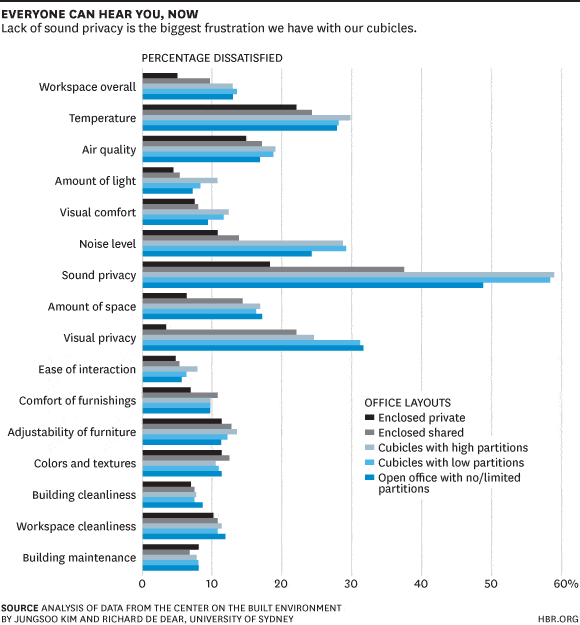10 Steps To Reduce Office Noise
Noise is a common complaint in corporate office settings, particularly in open-concept seating arrangements where employees occupy a large office with little to no separation. Constant activity and noise can distract and negatively affect productivity, stress, job satisfaction, and employee morale. That’s why productive businesses focus on reducing office noise.

Source Harvard Business Review
Research shows that 49% of workers report being unable to concentrate easily, while the average person loses 86 minutes daily due to distractions. To reduce noise in the office and improve employee productivity, consider implementing one or more of the following steps:
1. Noise-Friendly Flooring
Use noise-friendly materials such as engineered hardwood and LVT flooring, which are known for their sound absorption qualities and ease of maintenance. Not only do these materials look great and add a professional touch to any office space, but they also have the added benefit of reducing noise pollution. Engineered hardwood and LVT flooring are versatile, easy to clean and come in various design options. Additionally, LVT flooring has built-in sound absorption properties, but adding a rubber underlayment can provide even better insulation.
2. Dedicated Quiet Office Spaces
Create dedicated quiet spaces within the office layout, such as glass-encased, soundproof office cubes for employees to use when they need a break from the noise. These quiet spaces are becoming increasingly popular in modern offices, and for a good reason. They provide employees with a sanctuary where they can focus and work without distractions. A dedicated quiet space can be as simple as an empty conference room or as elaborate as a 100% soundproof office cube.
3. Noise-Canceling Headphones
Provide noise-canceling headphones to employees to block unwanted sounds. These headphones can help employees focus on their tasks by canceling out background noise. Some brands even offer 100% noise reduction.

4. White Noise
White noise is a background noise that can mask unwanted sounds in an office environment. This may seem counterintuitive, but it is a proven successful strategy for reducing noise in open office spaces. Studies have shown that using white noise can reduce the overall noise level in a space and make it easier for people to focus on their work. The principle behind this is that the constant background noise of white noise can mask or cover up other, more disruptive sounds. This can be especially helpful in open office spaces, where there may be a lot of chatter and other distractions.
5. Noise Reducing Office Furniture
Use sound-friendly furniture such as couches, lounge chairs, wall partitions, and filing cabinets to improve the acoustics of the office space. Office furniture can have a significant impact on the space’s acoustics. High-backed couches or enclosed booths, for example, can help to separate a person from the rest of the room, reducing noise distractions.
6. Add Office Plants
Evidence suggests that office plants effectively reduce noise levels and improve air quality. Not only do plants look great and add a natural touch to an office space, but they also have the added benefit of reducing noise pollution. The bigger the plant, the more significant the impact, so consider adding large potted plants to your office space.
7. Sound Absorbing Building Panels
Use soundproofing materials like acoustic panels, sound-absorbing ceiling tiles, and wall-mounted sound blockers. Professional soundproofing absorbs sound, reduces noise pollution, and makes it easier for employees to focus on their work. Acoustic panels, sound-absorbing ceiling tiles, and wall-mounted sound blockers can be installed in various office spaces, from conference rooms to open-plan offices.
8. Headphones On Calls
Encourage employees to use phones and headphones for personal calls. Personal and video calls can be significant noise sources in an office setting. By encouraging employees to use phones and headphones for personal calls, you can reduce the amount of noise pollution in your office.
9. Sound-Masking With Music
Incorporating sound-masking technology into open-plan offices can significantly reduce unwanted noise and create a more conducive work environment. Sound-masking technology emits background noise consistently, which can help to mask other, more disruptive sounds in the space. This can include various ambient sounds or even music. For example, ambient noise, such as gentle rain, soft music, or a babbling brook, can be played through speakers in the office to create a soothing background noise. This can help to mask the sound of nearby conversations and other distractions, making it easier for people to focus on their work. Similarly, white noise, such as the sound of a fan or a white noise machine, can also be used to mask unwanted sounds.
10. Establish Quiet Hours
Implement a “quiet hours” policy to minimize noise and distractions during specific times of the day. By implementing a “quiet hours” policy, you can establish specific times during which employees minimize noise and distractions. “Quiet hours” can be especially effective when employees need to focus on important tasks.
Meeting Your Noise Reduction Office Goals
By implementing these steps to reduce noise in the office, you can create a more productive and peaceful work environment for your employees. Whether you’re looking to reduce noise in a small office or a large open-plan office, there are many strategies you can use to minimize noise pollution and increase employee productivity.


